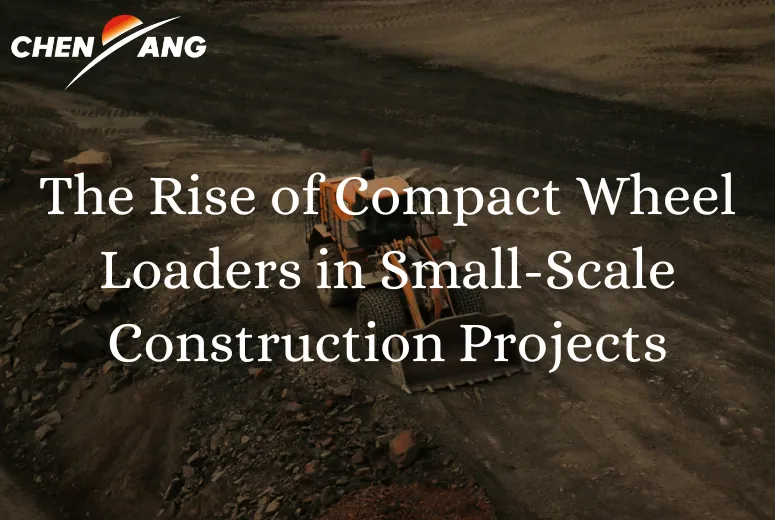The Rise of Compact Wheel Loaders in Small-Scale Construction Projects
Compact wheel loaders have gained significant traction in small-scale construction projects, providing solutions that combine efficiency, versatility, and ease of use. Unlike their larger counterparts, which are typically reserved for massive infrastructure developments, compact wheel loaders are well-suited to projects that require maneuverability in tight spaces and the ability to handle a variety of tasks. As construction demands evolve, these machines are becoming essential tools for contractors working on residential developments, landscaping, and light commercial construction. This article explores the rise of compact wheel loaders and their role in transforming small-scale construction operations.

Versatility for Diverse Applications About Compact Wheel Loaders
One of the primary reasons behind the rise of compact front end loader in small-scale construction projects is their versatility. These machines are capable of performing a wide range of tasks, from material handling to grading, digging, and lifting. In smaller projects where space is often limited, the ability to switch between different attachments—such as buckets, forks, and grapple arms—makes compact wheel loaders indispensable.
For instance, in a residential construction project, a compact front loader can efficiently move soil, gravel, and other construction materials. When equipped with the right attachments, these machines can also help with tasks like spreading and leveling materials, clearing debris, or even light excavation work. This versatility allows contractors to avoid needing multiple specialized machines, saving both time and money.
Maneuverability in Tight Spaces About Compact Wheel Loaders
Small-scale construction projects often take place in environments where space is constrained, such as urban areas, narrow lots, or residential neighborhoods. Large equipment may struggle to navigate these confined spaces, making compact machines like wheel loaders ideal for these tasks. Their compact design and exceptional maneuverability enable them to work in areas where larger machines would be impractical or unable to operate effectively.
A compact wheel loader can easily access hard-to-reach areas and make precise movements, which is particularly useful when working on projects where maintaining access to other parts of the site is essential. This ability to work in tight spaces without sacrificing productivity is a significant advantage for contractors focused on efficiency and minimizing disruption to the surrounding environment.
Cost-Effectiveness for Small-Scale Projects About Compact Wheel Loaders
In small-scale construction, budget constraints are often a significant consideration. Compact wheel loaders offer a more cost-effective solution than their larger counterparts, both in terms of upfront costs and operational expenses. These machines are typically less expensive to purchase, maintain, and operate, which makes them an attractive option for contractors working on residential or light commercial projects where large-scale machinery may not be financially viable.
In addition to the lower acquisition cost, compact wheel loaders also offer better fuel efficiency compared to larger machines. This reduction in fuel consumption directly translates into lower operational costs, making these machines an even more appealing option for small-scale construction companies that need to keep their expenses under control.
Enhanced Productivity and Speed With Compact Wheel Loaders
Despite their smaller size, compact wheel loaders are powerful machines that can handle a substantial workload. Their lifting capacity and digging depth may be smaller than those of full-sized loaders, but they are still more than capable of handling the tasks typically required in small-scale construction projects. This combination of power and compactness allows contractors to complete tasks more efficiently, reducing project timelines.
For example, compact wheel loaders can move materials faster than manual labor or smaller machinery like skid steers, reducing the time needed to transport goods across the site. Their efficient operation leads to a smoother workflow and better project management, which is crucial when working on projects with strict deadlines.
Easy Operation and Maintenance of Compact Wheel Loaders
Another key benefit of compact wheel loaders is their user-friendly design. These machines are relatively easy to operate, even for those with limited experience with heavy machinery. Their controls are intuitive, and many models come equipped with ergonomic features that reduce operator fatigue. As a result, smaller construction teams can operate these machines with minimal training, improving workforce efficiency.
Additionally, compact wheel loaders are generally easier and less expensive to maintain than larger machines. With fewer complex components and more straightforward mechanics, these machines require less frequent repairs and have lower servicing costs. This ease of maintenance ensures that contractors can keep their machines in good working order with minimal downtime, which is essential for maintaining productivity on small-scale projects.
Environmental Benefits and Sustainability of Compact Wheel Loaders
In today’s construction environment, sustainability is a key consideration. Compact wheel loaders are generally more fuel-efficient than larger models, producing fewer emissions and consuming less fuel. This makes them a more environmentally friendly option for construction projects that aim to minimize their carbon footprint.
In addition to fuel efficiency, some compact wheel loaders are now being designed with electric or hybrid power systems. These greener alternatives allow contractors to further reduce emissions and comply with increasingly stringent environmental regulations. For projects located in urban areas or near residential zones, using low-emission machinery is particularly beneficial in reducing the impact of construction noise and air pollution.
-
Low Maintenance + High Availability of Ownership for Mining Dump TruckNewsJul.17,2025
-
Drum Drive Axle + Air Suspension for Electric Tractor TruckNewsJul.17,2025
-
33m Boom + Full Hydraulic Outriggers: Narrow-Site Construction Practices of Mixer Pump TruckNewsJul.17,2025
-
18L Large Drum + Extended Drain Interval of Gear Oil for Heavy Duty TrucksNewsJul.17,2025
-
13m Cargo Space + Polyurethane Insulation: Long-Term Cold Chain Protection Solutions for Refrigerated Semi-Trailers for SaleNewsJul.17,2025
-
10T Water Tank + 2.5MPa Fire Pump Efficiency Analysis of Water Tank Fire TruckNewsJul.17,2025
Popular products

























